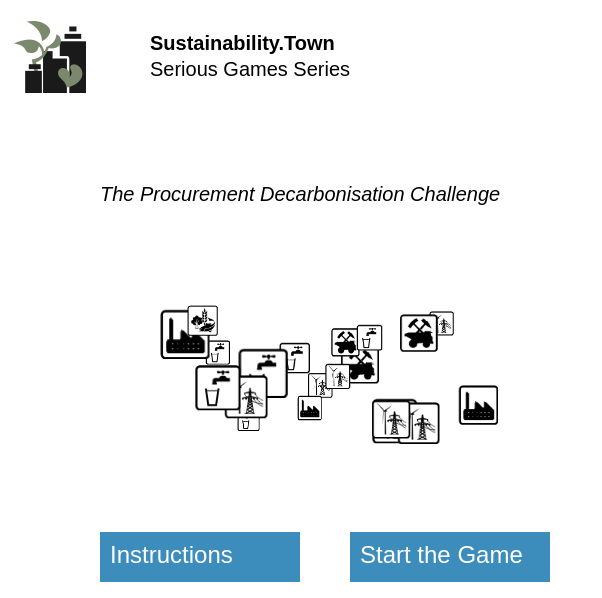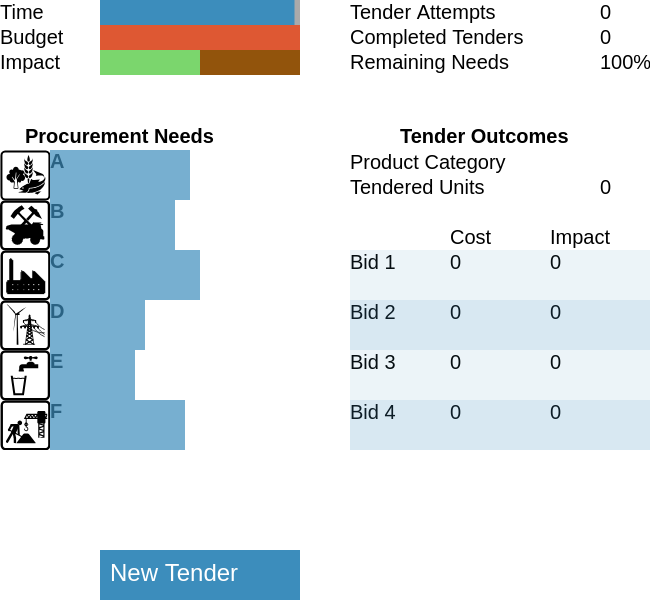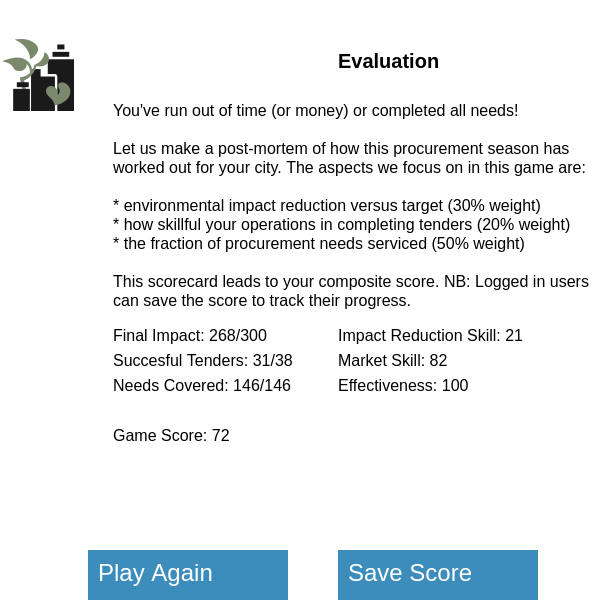The Green Public Procurement Challenge (Online Game)
In this post we introduce a new online game that aims to familiarise with various challenging aspects of Green Public Procurement
Motivation
The substantial potential of Green Public Procurement towards achieving sustainability objectives is well known. But the transition process involves significant complexity and implementation barriers. The combination of diverse categories of products and services, each with their own specific sustainability and knowledge requirements and the need for augmented organizational capacities to handle expanded information flows is a formidable challenge. In a new and free online game we introduce some aspects of these challenges in a simplified, fun setting that helps highlight some of the considerations involved.
Sustainability.Town
The GPP challenge game is hosted in the sustainability.town, an online platform dedicated to hands-on demonstrations and applications of Sustainable Portfolio Management concepts and methodologies. It is part of a new series of serious games covering a wide range of important concepts in an engaging manner.

Gameplay
In the game the player assumes the role of a public procurement manager working for a large city. The gameplay imagines our intrepid public servant (namely, you!) inheriting a challenging procurement portfolio that has a substantial environmental footprint (in terms of excess Greenhouse gas emissions). The general objective is to use the next procurement season to reduce the city’s environmental impact by making optimal choices when various procurement tenders materialize.

Alas, inherited a challenging procurement portfolio. It keeps the great city of ours ticking, but needs some shrewd interventions if it is meet its sustainability goals. Your composite objective is to reduce Greenhouse gas emissions from procured goods and services, even while fulfilling all the city’s procurement needs and staying within budget and of course delivering everything on time!
For each tendering process you will need to pick wisely from the available bids as those land on your desk. You need to reduce your carbon footprint while keeping an eye on the costs of alternative proposals. Like in real life, pursuing sustainability is not a simple exercise. The procurement officer must meet the city’s procurement needs across different product categories (here, six major sectors) with a limited budget and within a limited time. This requires careful evaluation and selection from among the various bids.
Landing Scene
The landing scene for the game provides you with the option to refresh the instructions or start playing the game. Once you press start the time starts running, so be sure to be ready! Time is of the essence and it is displayed at the top of the screen as a diminishing blue bar. Once the time runs out, it is game over and your performance will be evaluated.

After the lapsing of time, the next critical resource you need to keep an eye on is your budget. This is shown as a reddish bar at the top. You need to cover the needs of your city with the available money. Once the money runs out it is again game over, as it is not possible to fulfil any other procurement needs.
The Procurement Needs for each category of product (sector) are the blue horizontal bars that tell you how much is needed for the current year (in product units). Each successful tender reduces the needs for that product which ideally should reduce to zero within the allotted time. The total remaining needs are indicated on the top right hand side as a percentage.
The Tender Process
You start the tendering process by pressing the New Tender button. The product that is been procured is picked at random from those that have ongoing procurement needs (this is to simplify the gameplay but also illustrates the chaotic order in which needs may need to be fulfilled).
Pressing the button triggers a biding process. The amount of product that will be available will vary, emulating market volatility or other constraints.
Available Bids: For each tendering process there are always four bids to choose from. They differ in cost and environmental impact per unit.
Cost is the cost per unit which is multiplied by the number of units for the total cost. This is subtracted from your budget.
Impact is the environmental impact (here imagined as GHG emissions per unit). This is multiplied by the number of units and added to your running footprint profile. The starting condition is the cumulative environmental impact of the last procurement season. This is indicated with the brown bar. Your environmental target is indicated with the green portion.
Selecting a Bid is done by Clicking on a bid. This immediately calculates its effects (reducing the procurement needs for that sector and adjusting the budget and environmental impact.
NB: You can reject all bids and ask for a new tender as many times as you like. But besides losing time, this reduces your market savvy score (more below).
Game Scene

Strategy
Well, that is your job to figure out! Observe what happens and adjust your choices accordingly.
Evaluation
Once you run out of time or money or (if you’ve become a procurement expert) you managed to fulfill all needs, the game ends and you are shown the evaluation screen.
Here you are presented with a post-mortem of the procurement season. The aspects being highlighted (and scored) are game are:
- the degree of environmental impact reduction versus target (30% weight)
- how skillful your operations in completing tenders (20% weight)
- the fraction of procurement needs serviced (50% weight)
In other words, there is a scorecard with the above indicated weights that leads to your composite score.
NB: Logged in users can save the score to track their progress.

Simplifications
Of course to reduce the complicated green public procurement process to a simple game requires some pretty drastic simplifications. Even an enumeration would be a very long list. Maybe the most glaring one, in terms of realism that in order to simplify the gameplay, all product units are normalized and treated as homogeneous.
Go ahead, play the game and tell us what you think of it!